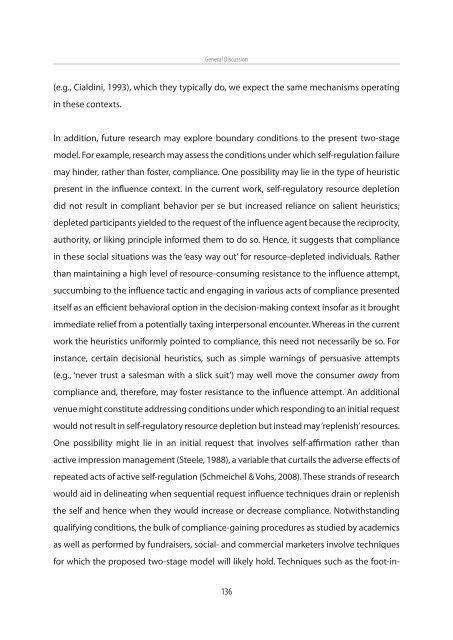Chapter 1 - Universiteit Twente
Chapter 1 - Universiteit Twente
Chapter 1 - Universiteit Twente
You also want an ePaper? Increase the reach of your titles
YUMPU automatically turns print PDFs into web optimized ePapers that Google loves.
General Discussion<br />
(e.g., Cialdini, 1993), which they typically do, we expect the same mechanisms operating<br />
in these contexts.<br />
In addition, future research may explore boundary conditions to the present two-stage<br />
model. For example, research may assess the conditions under which self-regulation failure<br />
may hinder, rather than foster, compliance. One possibility may lie in the type of heuristic<br />
present in the influence context. In the current work, self-regulatory resource depletion<br />
did not result in compliant behavior per se but increased reliance on salient heuristics;<br />
depleted participants yielded to the request of the influence agent because the reciprocity,<br />
authority, or liking principle informed them to do so. Hence, it suggests that compliance<br />
in these social situations was the ‘easy way out’ for resource-depleted individuals. Rather<br />
than maintaining a high level of resource-consuming resistance to the influence attempt,<br />
succumbing to the influence tactic and engaging in various acts of compliance presented<br />
itself as an efficient behavioral option in the decision-making context insofar as it brought<br />
immediate relief from a potentially taxing interpersonal encounter. Whereas in the current<br />
work the heuristics uniformly pointed to compliance, this need not necessarily be so. For<br />
instance, certain decisional heuristics, such as simple warnings of persuasive attempts<br />
(e.g., ‘never trust a salesman with a slick suit’) may well move the consumer away from<br />
compliance and, therefore, may foster resistance to the influence attempt. An additional<br />
venue might constitute addressing conditions under which responding to an initial request<br />
would not result in self-regulatory resource depletion but instead may ‘replenish’ resources.<br />
One possibility might lie in an initial request that involves self-affirmation rather than<br />
active impression management (Steele, 1988), a variable that curtails the adverse effects of<br />
repeated acts of active self-regulation (Schmeichel & Vohs, 2008). These strands of research<br />
would aid in delineating when sequential request influence techniques drain or replenish<br />
the self and hence when they would increase or decrease compliance. Notwithstanding<br />
qualifying conditions, the bulk of compliance-gaining procedures as studied by academics<br />
as well as performed by fundraisers, social- and commercial marketers involve techniques<br />
for which the proposed two-stage model will likely hold. Techniques such as the foot-in-<br />
136
















